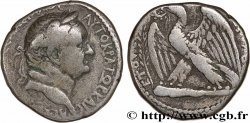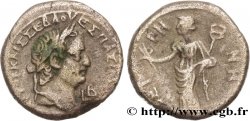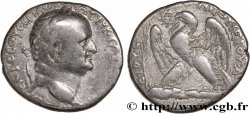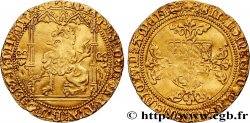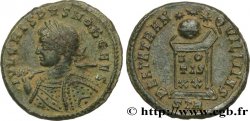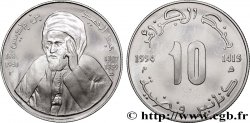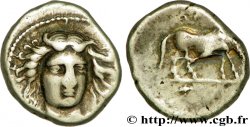v55_0126 - VESPASIANO Denier
MONNAIES 55 (2012)
Precio de inicio : 350.00 €
Valoración : 550.00 €
Precio realizado : 480.00 €
Número de ofertas : 4
Oferta más alta : 520.00 €
Precio de inicio : 350.00 €
Valoración : 550.00 €
Precio realizado : 480.00 €
Número de ofertas : 4
Oferta más alta : 520.00 €
Tipo : Denier
Fecha: 70
Nombre del taller / ciudad: Roma
Metal: plata
Milésimas de pureza : 900 ‰
Diámetro: 16 mm
Eje de acuñación: 6 h.
Peso: 3,53 g.
Grado de rareza: R2
Comentarios sobre el estado de conservación:
Exemplaire sur un petit flan ovale, bien centré des deux côtés, court sur la légende de droit. Beau portrait primitif de Vespasien. Joli revers à l’usure superficielle, particulièrement bien venu à la frappe. Patine grise superficielle avec des reflets dorés
N° en los catálogos de referencia :
Anverso
Titulatura del anverso: [IMP] CAESAR VESPASIANVS AVG.
Descripción del anverso: Tête laurée de Vespasien à droite (O*).
Traducción del anverso: “Imperator Cæsar Vespasianus Augustus”, (L'empereur césar Vespasien auguste).
Reverso
Titulatura del reverso: IVDAEA (À L'EXERGUE).
Descripción del reverso: La Judée voilée assise à droite ; derrière un trophée.
Traducción del reverso: “Iudæa”, (La Judée).
Comentario
Rubans de type 2. Au droit, le portrait est réaliste et ressemble aux portraits plus massifs de l’empereur, plus tardifs. Peut-être l’émission a-t-elle débutée avant l’arrivée de l’empereur dans l’Urbs qui était absent de Rome depuis quatre ans. Ce type de revers n’a été frappé qu’en 70 pour l’or et l’argent (RIC. 15). Mais le style du portrait fait aussi penser à Lyon (RIC. 1118). La Judée est toujours assise à droite, voilée, le bras droit posé sur son genou et le bras gauche soutient le menton de la Province qui suivant les exemplaires, est plus ou moins penché vers l’avant dans une attitude de tristesse. Nous trouvons parfois de petites variations dans la représentation du trophée d’armes qui est constitué d’un casque, d’une cuirasse, de boucliers ronds au sol et de boucliers composites sur les bras du trophée .
Type 2 ribbons. On the obverse, the portrait is realistic and resembles the later, more massive portraits of the emperor. Perhaps the issue began before the arrival of the emperor in the Urbs, who had been absent from Rome for four years. This type of reverse was only struck in 70 for gold and silver (RIC. 15). But the style of the portrait is also reminiscent of Lyon (RIC. 1118). Judea is always seated on the right, veiled, her right arm resting on her knee and her left arm supporting the chin of the Province, who, depending on the copy, is more or less leaning forward in an attitude of sadness. We sometimes find small variations in the representation of the trophy of arms, which consists of a helmet, a breastplate, round shields on the ground and composite shields on the arms of the trophy
Type 2 ribbons. On the obverse, the portrait is realistic and resembles the later, more massive portraits of the emperor. Perhaps the issue began before the arrival of the emperor in the Urbs, who had been absent from Rome for four years. This type of reverse was only struck in 70 for gold and silver (RIC. 15). But the style of the portrait is also reminiscent of Lyon (RIC. 1118). Judea is always seated on the right, veiled, her right arm resting on her knee and her left arm supporting the chin of the Province, who, depending on the copy, is more or less leaning forward in an attitude of sadness. We sometimes find small variations in the representation of the trophy of arms, which consists of a helmet, a breastplate, round shields on the ground and composite shields on the arms of the trophy







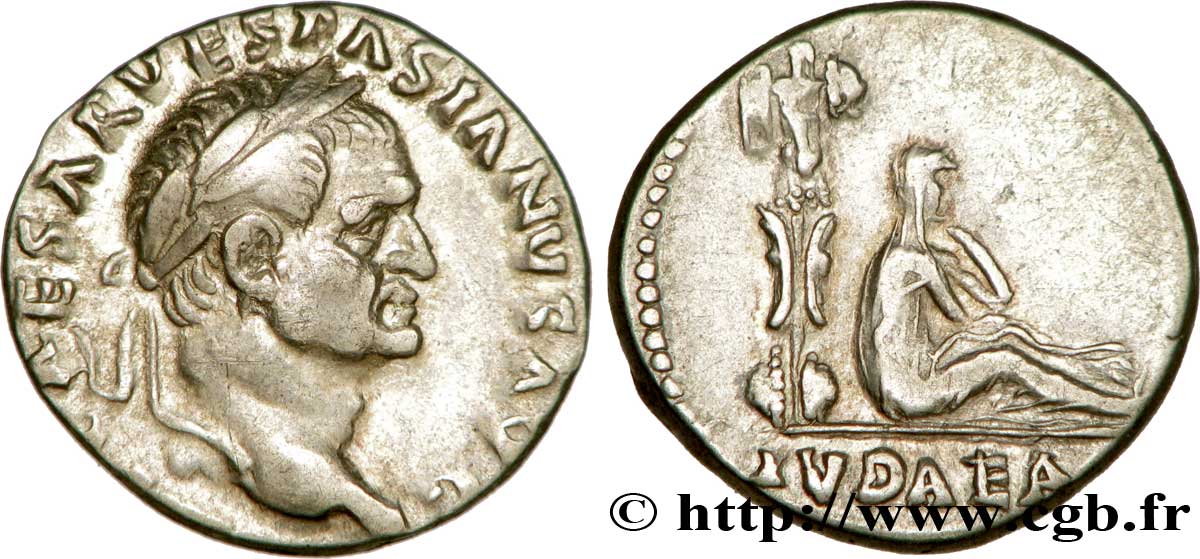
 Informar de un error
Informar de un error Imprimir la página
Imprimir la página Comparte mi selección
Comparte mi selección Haz una pregunta
Haz una pregunta Consignar / vender
Consignar / vender
 Descriptivo
Descriptivo